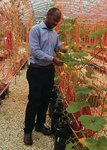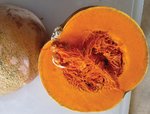The calabaza, a specialty pumpkin traditionally used in Caribbean, South and Central American dishes, has a powerhouse of potential that scientists like Geoffrey Meru are looking to crack open.
Join our family of readers for as little as $5 per month and support local, unbiased journalism.
Already have an account? Log in to continue. Otherwise, follow the link below to join.
Please log in to continue |


HOMESTEAD — The calabaza, a specialty pumpkin traditionally used in Caribbean, South and Central American dishes, has a powerhouse of potential that scientists like Geoffrey Meru are looking to crack open.
Meru, a vegetable geneticist at the UF/IFAS Tropical Research and Education Center, is leading a multi-institutional project aimed at adding value to the calabaza commodity chain by eliminating barriers in seed and cropping systems, as well as laying a foundation for novel and lucrative products. The study will determine whether the calabaza provides the right combination of profit, wider consumer demand and usefulness for a variety of industries. Aside from it being a traditional staple in cultural dishes for some, Meru will look at the calabaza as the next pumpkin of choice for those working in the brewing, food, agriculture, manufacturing and health industries.
“The calabaza is a nutritional powerhouse that is easy to grow almost pest free, and an excellent crop you can use in rotation with others,” said Meru. “Because it is adapted to Florida’s tropical climate with minimal irrigation requirements, we want to take a closer look at its desirable qualities as a sustainable Florida crop.”
With help from a two-year, nearly $400,000 U.S. Department of Agriculture grant, Meru will lead a team of UF/IFAS researchers in food science, human nutrition and community sciences.
They will learn about the risks and benefits of crop production, predict market interest for consumption of the calabaza’s flesh and other lucrative products, determine the nutrition value of this specialty pumpkin, and develop conventional and organic-cropping systems that suppress weeds and improve soil. They’ll also determine the best cultivars for the Florida, Georgia and Puerto Rico markets.
The grant, in collaboration with the universities of Puerto Rico and Georgia, is aptly named “Specialty Pumpkin: Laying the Groundwork for an Emerging Crop and Lucrative Products.”
Together, the team plans to:
• Engage growers, industry stakeholders and consumers to assess potential risks and benefits of specialty pumpkin production.
• Determine sustainable production strategies, costs.
• Understand and eliminate barriers to potential consumer acceptance and identify demands for products developed with calabaza.
The project will examine genetic variation of cultivars for calabaza components such as yield, flesh quality, pumpkin shape and size, rind thickness and seeds for use as product ingredients. They will also examine pest resistance in search of resilient cultivars.
Why do people have a passion for the calabaza? As a crop, it has multiple varieties to choose from, plenty of nutritional benefits and the ability to be used in its entirety from its rind right down to the seeds, adds Meru.
Chefs, consumers and manufacturers tout the flavor and labor for the calabaza as a low-calorie, high-fiber, high-energy food that is a rich in vitamin A. Seeds are sought by the snack food industry and by manufacturers of pumpkin seed butter as it is a non-allergenic, nutritious alternative to nuts and nut butters. The flesh is ideal for canning while the tastes and consistency can vary.
Organically grown produce is a priority for many restaurants, community supported agriculture and for baby food. Optimized organic and conventional cropping systems will be needed to maximize profitability for growers supporting these industries.
“Part of the goal is to understand and examine the favorable attributes such as flavor, nutrition, high-yielding cultivars, long-term storage, shipping quality, and seed availability that are important to growers, suppliers and consumers,” said Meru. “Another goal is to optimize profitability, the potential for new job growth with this crop, along with the availability of seeds, varieties and hybrids when needed.”
“Growers want to make more money per acre, which means we have to breed cultivars that yield more fruit per acre,” he said.
His program also breeds for improved fruit quality, including fruit shape and sweetness, which can help growers succeed in the market.